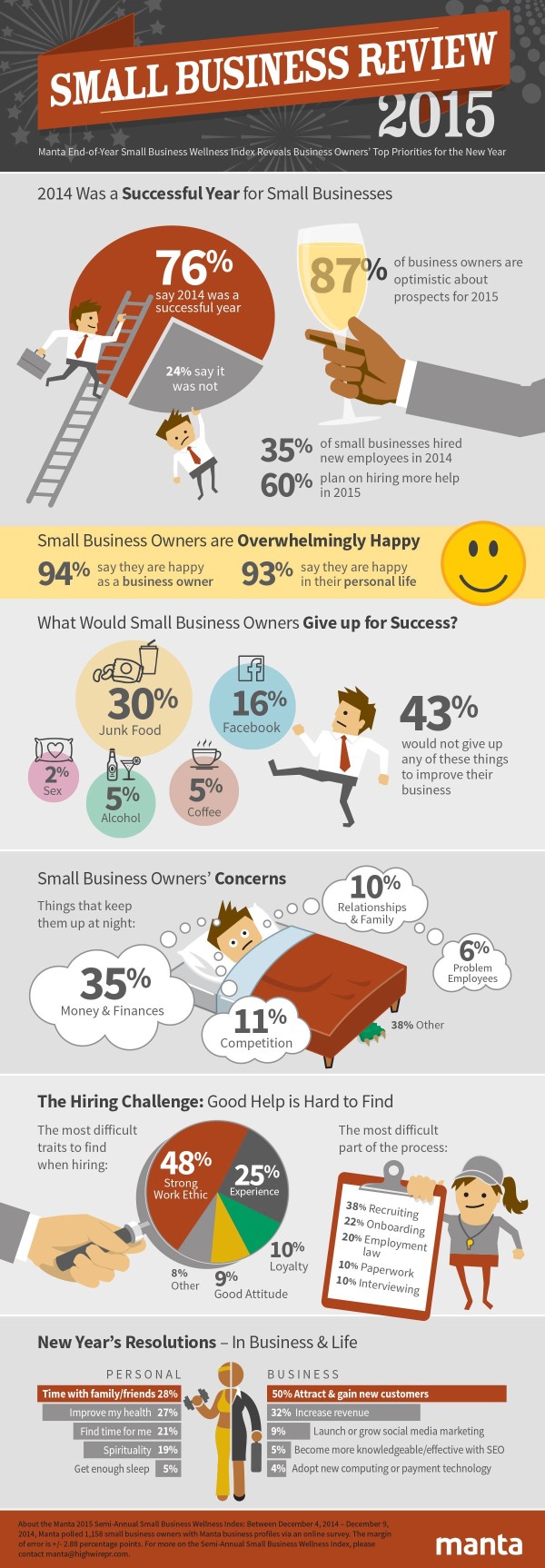By Rieva Lesonsky
10 Things Entrepreneurs Need to Know
1). Is Everybody Happy?
According to a new survey from Manta, most small business owners are happy with their lives—both business and personal—right now. In fact, 76 percent say 2014 was a “successful year” for them, 94 percent are happy owning a business and 93 percent are leading “happy personal lives.” This joy is not short-lived either—87 percent are optimistic about their business prospects in 2015.
When asked what personal habits they’d give up for increased business success, 43 percent wouldn’t give up any thing, 98 percent refused to give up sex, while 30 percent would give up eating junk food and 16 percent would bid adieu to Facebook (which seems low to me).
What resolutions did they make? Half want to “win new customers”, one-third plan to “increase revenues” and 28 percent will spend more time with family and friends.
As for what keeps them up at night, 35 percent are losing sleep over money and financing, while 11 can’t sleep because of competition from big businesses.
The good news is 60 percent will hire either full or part-time employees (35 percent added staff last year), and report it’s hard to find employees with a strong work ethic.

2). Online Holiday Sales Climb
Adobe just released its Online Holiday Shopping Report. Among the key findings:
- Total sales: U.S. retailers raked in $73.4 billion in online sales, up 12 percent from last year. The holiday season generated 28 percent of total annual online sales for retailers.
- Winners & Losers: Winners: specialty, general merchandise, and apparel retailers. Losers: jewelry, food & drug, and health & beauty retailers.
- In-store pickup became a key differentiator for brick-and-click over online-only retailers. Black Friday alone saw in-store pickups soar 40 percent above the average day.
- Mobile represented 16 percent of all online sales, peaking at 29 percent on Thanksgiving Day and Black Friday. iPad users drove 48 percent of mobile sales.
More details (including international data) are available at CMO.com.
3). Are You Safe?
According to a Norton cybersecurity survey of small businesses, cybercriminals are the threat small businesses are least prepared for. While 47 percent of small businesses know how to protect themselves from a physical theft and 78 percent have security systems installed on their premises, only 31 percent claim to understand how to combat today’s cybercriminal. Less than half (46 percent) say they’re well-protected against computer viruses and malware—and 37 percent report falling victim to computer viruses over the past year.
The survey also reports that:
- Mobile devices are more vulnerable. While most businesses have a cybersecurity system installed on their desktops (98 percent) and laptops (96 percent), only 65 percent have one on their tablets and 56 percent protect their smartphones.
- Password management is lax: 44 percent of companies don’t mandate how often to change passwords.
- Lapses in security are costly. Over the past year problems resulting from Internet security issues or incidents cost the average small business $1,600 and two days of lost work time.
- Keeping an eye on the wrong “ball”. More business owners want tickets to the Super Bowl (43 percent) than want to improve how they manage Internet security (28 percent).
To protect your small business, Norton says you need to:
- Be proactive: Security updates for your computer operating system or software may arrive too late. Without a protection system that is both proactive and thorough, you’re leaving your company open to vulnerability. Norton Security provides small businesses with the protection they need.
- Create reminders: Set up automatic updates for essential software, which helps lower the risk of malware spreading through the network.
- Go wireless: Use wireless encryption in order to establish a secure protection against cybercriminals.
4). Small Businesses Aren’t Seeking Much Money
The Federal Reserve Banks of New York, Atlanta, Cleveland and Philadelphia just jointly released findings from their Small Business Credit Survey, which found significant differences in credit demand across firm size segments during the first half of 2014. The report also highlighted the difficulty many small businesses have accessing credit.
Key findings of the Small Business Credit Survey include:
Small and large companies (measured by revenue) had wide difference in credit demand. While 22 percent of firms overall applied for credit in the first half of 2014, only 18 percent of microbusinesses (those with less than $250,000 in annual revenue) did. By contrast, over 30 percent of SMBs ($250,000-$10 million in revenues) and 58 percent of big businesses (more than $10 million in revenues) sought credit.
Companies want money—but not a lot—to expand. Over half of companies applying for credit sought $100,000 or less. Almost 40 percent reported the primary purpose of borrowing was to expand their businesses.
Where’s the money coming from? Small businesses primarily turned to large national and regional banks for financing, but almost 20 percent applied to an online lender in the first half of 2014. Approval rates were highest at the large and small regional banks and online lenders. Of those applying to small regional or community banks, 60 percent were approved for at least some of the financing they sought.
The states covered in the survey: Alabama, Connecticut, Florida, Georgia, Louisiana, New Jersey, New York, Ohio, Pennsylvania and Tennessee.
5). Recruiting New Employees via Social Channels
Recruiters these days have more ways than ever to find candidates online or through social channels, and powerful technologies to efficiently manage everything from recruiting to onboarding to employee experience.
But is social recruiting as successful as we’ve been led to believe? FinancialForce.com just released results of a recent survey they conducted which shows, “Social is important when it comes to recruiting, especially with Millennials, but there’s a lot of room for improvement.”
The results of the survey were interesting. (Click on each percentage for detailed information). Key findings include:
- 55 percent of Millennial welcome recruiters contacting them via social channels
- 82 percent of those surveyed who have used social media as a job search tool say the lead was successful.
- 56 percent don’t use social channels for job searches or during the interview process.
- 28 percent have used a tablet or mobile phone to search for jobs.
- 14 percent have applied for jobs via mobile devices, but 72 percent prefer to search for jobs on desktops or laptops.
Check out the full survey results.
Looking at those highlights a little more in depth, if you’re recruiting you’d be wise to use a number of different channels to find good employees. Since more than half of people aren’t using social platforms to find a job, make sure you’re posting openings where they are. Most jobs seekers make job boards (26 percent), Google (25 percent) or company websites (24 percent) their first destination. FinancialForce advises you to make sure your job pages are constantly updated with the latest openings.
Of the social channels used to look for a job, LinkedIn leads the pack (25 percent), while Facebook is next with 19 percent saying they’re used it.
You also need to be careful before you unleash your recruiters on social networks. Among those who use social media when looking for a job, 17 percent “direct contact from a recruiter” is the most successful way to reach them, but 61 percent do not want recruiters to contact them via social channels at all.
Not so surprisingly, Millennials (18-34 in this survey) are much more avid users of social networks for job hunting—55 percent of them “welcome companies reaching out to them” via social channels.
6). Job Growth Report
Speaking of jobs, TriNet, a leading cloud-based provider of HR services, just released the December issue of TriNet SMBeat, its monthly analysis of small business employment and human capital economic indicators, including an analysis of overall net job growth for 2014. According to the report, technology and professional services were the hottest-growing sectors of 2014, boasting annual net job growth of 49 percent and 26 percent, respectively.
This growth trend for technology jobs will likely continue as the forecast for the first half of 2015 looks bright for IT workers. According to CIO.com, 87 percent of chief information officers plan to add staff, which could lead to upward pressure on salaries and benefits, making it necessary for companies to employ better engagement and retention strategies if they want to hold on to key talent.
Atlanta, Los Angeles and Boston led the way in technology job growth, while in the professional services arena, New York and California were tops.
7). Conference Calls Pay Off for Some Small Businesses
InterCall, the world’s largest conferencing provider, surveyed U.S. small business owners to measure their use of conferencing technology and how it affects their productivity and personal lives. The study shows overall 70 percent of small business owners use audio and/or video conferencing technology. But certain small business owners are reaping more benefits of the technology than others.
Younger entrepreneurs are more likely to use conferencing services to improve their work/life balance. In fact, 72 percent of younger business owners (between 18 & 29) have adopted conferencing and collaboration tools, compared to 53 percent of owners between 45 and 60.
Other survey highlights include:
39 percent spend more than 10 hours and $100 per month on business travel, leading only 32 percent to say they enjoy a healthy work-life balance.
Female entrepreneurs are more likely to use conferencing technology than males (68 percent vs. 60 percent).
Young small business owners are more than twice as likely to spend their additional free time “doing nothing” compared to those ages 45-60 (55 percent vs. 24 percent).
8). 9 Common Characteristics of Successful Business Owners
What enables some startup entrepreneurs to succeed? According to Chuck Pistor, the CEO of Miracle Method, a franchise company, the most successful business owners share some common traits, including:
Ambition: which is the spark that fuels the passion and drive of small business owners. It’s what gets them out of bed early in the morning after a late night of work, and quickly gets them back in the saddle when things don’t go as planned. It is essential for business owners to be forward thinking and invested in continually developing and improving their businesses. Without this mindset, chances are it’s just a matter of time before you’re headed for the exit.
Self-motivated and driven: Every day is a new opportunity to make great things happen and turn ideas into action. Successful entrepreneurs embrace speed bumps as opportunities for learning and growth.
A Good Juggler: A small business owner must be able to effectively execute on a multitude of skills, and become a master in the art of delegation. Aside from being undercapitalized, the inability to effectively be a good juggler of daily responsibilities is the number one reason that small businesses fail.
A problem solver & decision maker: Small business owners make dozens of decisions each day, many of which must be made in the moment. It is critical to approach these opportunities with the confidence to quickly assess the issue and execute on the best available solution.
An effective manager: Business owners must be committed to the welfare of their employees. Effective managers earn trust, are strong collaborators and have the ability to prepare and develop their team for success. They are invested in not only motivating employees toward a collective goal, but also providing them with the tools necessary for growth.
A people person: You certainly don’t have to be an extrovert to be a people person, but it does help to be adaptable and comfortable in almost any environment. As a small business owner, it sometimes feels as if you are ‘on’ all day- engaging with your employees, vendors, and customers. Even when you’re feeling less than social, a willingness to meet people and create connections is important.
A PT Barnum: Successful entrepreneurs almost always share one trait in common—genuine excitement about their work. They are comfortable with self-promotion, and have a passion for sharing the story of their businesses with others. Enthusiasm is contagious.
Competitive: Would you consider an entrepreneur to be an athlete? The physical training component may look very different, but successful small business owners have indeed tapped their inner competitors. They are driven to be the best in their fields, and aren’t satisfied with second place.
Sympathetic: No matter what industry your business falls under, your employees and customers can set you up for success—or for a big headache. Misunderstandings and challenges will surely arise, but a flair for really listening and making fair resolutions in the best interest of both your business and your people go a long way.
9). Are Your Employees Stressed?
A recent survey from lynda.com, an online learning company, shows 94 percent of working professionals feel more pressure than ever to know it all and that nearly half don’t have confidence in their current job skills. In response, says the company, “many are taking their professional development into their own hands.”
According to Tanya Staples, lynda.com’s senior vp of content, “More than 80 percent of those surveys learn skills on their own time, at home, late at night and on weekends.”
The survey also shows:
- 93 percent are very interested in learning new skills to gain more confidence in their jobs
- 78 percent think learning new skills will be critical to their success
- Women (56 percent) are less confident in their skills than men (44 percent)
- More than half feel the most pressure to learn technology & software skills.
10). Going Virtual
Allowing your employees to work virtually can save your business money and boosts employee satisfaction, which increases the chances they’ll stay with your company. Kira Makagon, EVP of Innovation at RingCentral, says there are several good reasons to allow your team to work virtually:
- The cloud enables employees to use applications and data regardless of where they are or what devices they use
- Advances in device technology decreases the need for laptops and desktop computers, saving you money
- Additional integration between business apps and cloud communication apps make it easier to run a virtual business
- More employees want to work for companies with BYOD policies.
Rieva Lesonsky is CEO of GrowBiz Media, a media and custom content company focusing on small business and entrepreneurship. Email Rieva at rieva@smallbizdaily.com, follow her on Google+ and Twitter.com/Rieva
Want to know more? Read on…
Getting Organized, Small Business Predictions and More
Cooking Lessons for Startups, Video Contests and More
Wrapping Up Another Year, Marketing and More







